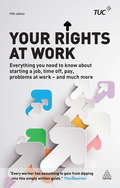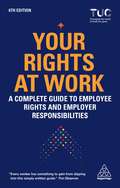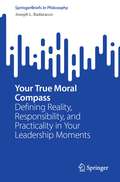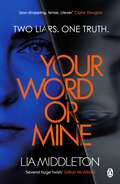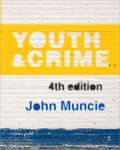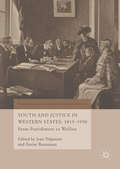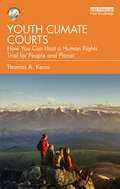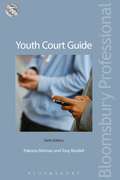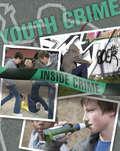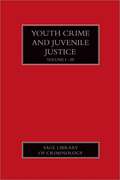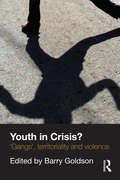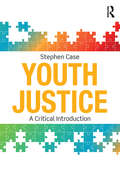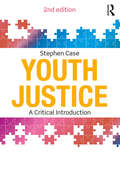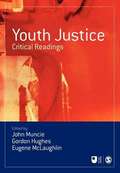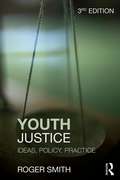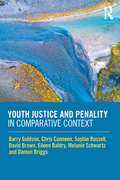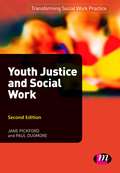- Table View
- List View
Your Rights at Work: Everything You Need to Know About Starting a Job, Time off, Pay, Problems at Work - and Much More!
by Trades Union TUCYour Rights at Work is a comprehensive, jargon-free guide to the legal rights of the employee and the responsibilities of the UK employer. Accessible and reliable, it offers real solutions to the problems and issues that can face anyone at work. Using the law is always a last resort, but if you have to take that step, there is practical advice on that too. Topics covered include: starting a job; parental leave and maternity rights; flexible working; equality law; dismissal and redundancy; pay and holiday rights; grievance procedures and how to enforce your rights. Your Rights at Work is written by employment experts at the Trade Union Congress (TUC). As the people who campaigned for many of the rights set out in this book, there is no one better to explain how they should apply in your workplace and what to do if they don't.
Your Rights at Work: A Complete Guide to Employee Rights and Employer Responsibilities
by Trades Union Congress TucAre you afraid your employer might be infringing your workplace rights? Or are you an employer seeking information on your responsibilities? Written by employment experts at the Trade Unions Congress (TUC), this book sets out Your Rights at Work in simple and relatable terms.This book explains the rights of the UK worker and responsibilities of the UK employer, and explains them clearly. It offers jargon-free guidance that can be applied to any situation in work including: parental leave and maternity rights, flexible working, dismissal and redundancy, pay and holiday rights and grievance procedures.This edition has been updated to include the impact of the COVID-19 crisis, Britain's exit from the EU and regulatory changes to data protection laws, holiday pay and gender gap reporting. Protect your employees and be empowered as an employee by knowing Your Rights at Work.
Your True Moral Compass: Defining Reality, Responsibility, and Practicality in Your Leadership Moments (SpringerBriefs in Philosophy)
by Joseph L. BadaraccoThis book presents a new, powerful, and practical way of making final decisions on the hard, complex, uncertain problems of life and work. What if you have looked at the data, talked with trusted colleagues, and applied all the relevant managerial and ethical frameworks, but you still don't know what is right. How should you make your final decision?This crucial question is rarely asked or answered. And some standard answers – follow your moral compass, your conscience, or your values – offer more inspiration than practical guidance. This book argues that, when we make final, hard decisions, we learn what is right by defining – personally – what is right. We find moral clarity by creating it. The book presents a fresh, challenging, and practical perspective on our hardest decisions. It offers a new conceptual approach for teachers and scholars and practical guidance for leaders and managers.
Your Word Or Mine: A tense, twisty and gripping new crime thriller. Who will you believe?
by Lia MiddletonWhat lies would you tell to uncover the truth? . . . THE UNPUTDOWNABLE NEW THRILLER PERFECT FOR FANS OF ANATOMY OF A SCANDAL'Tense, jaw-dropping, clever' CLAIRE DOUGLAS, author of THE COUPLE AT NO.9'Had me on the edge of my seat' 5* Reader Review'Keeps you guessing from start to finish. A fabulous read!' JANE FALLON, author of JUST GOT REAL'I loved it. Huge twists' GILLIAN McALLISTER, author of WRONG PLACE, WRONG TIME'Just when you think you have it figured out, another bombshell of a twist drops' SAMANTHA DOWNING, author of MY LOVELY WIFE_________Prosecutor Ava Knight always plays by the rules.Until she meets fifteen-year-old Lily Hawthorne, accused of stabbing hotel magnate Michael Osborne in cold blood.It should be an open-and-shut case. But Ava suspects something everyone else does not:MICHAEL OSBORNE IS LYING.Because eighteen years ago, Ava was brutally assaulted. The case went to trial. Her attacker was acquitted.His name? Michael Osborne.Now, court is in session.And Ava must decide how far she's willing to go to uncover the truth . . ._________Readers LOVE Your Word Or Mine'A genuine twist that left me open mouthed as I turned the last page' 5* Reader Review'The author does it again. Full of twists, fast-paced . . . I was hooked' 5* Reader Review'Tense and emotional, characters so real they almost step off the page . . . one of the most pacy thrillers I've read in a while' 5* Reader Review'Wow! What a book! This had me holding my breath' 5* Reader Review'Fast paced, suspenseful, scarily believable' 5* Reader Review'Shocking, clever and unpredictable' 5* Reader ReviewPraise for Lia Middleton'Brilliantly written . . . I'll be recommending it to everyone I know' Sarah Pearse, Sunday Times bestselling author of The Sanatorium'A stand-out psychological thriller' Ashley Audrain, Sunday Times bestselling author of The Push'Superb. Assured, elegant and utterly gripping' Will Dean, author of The Last Thing to Burn'Couldn't put it down' Catherine Cooper, Sunday Times bestselling author of The Chalet
Youth and Crime (4th edition)
by John MuncieThis book provides you with the most comprehensive and authoritative overview of youth crime and youth justice available. Keeping you abreast of contemporary debates, this fourth edition of Youth and Crime : Includes updated chapters on youth crime discourse and data, youth victimology, youth and social policy, youth justice strategies and comparative and international youth justice, providing a critical analysis of issues such as institutional abuse, child poverty, cyberbullying, child trafficking, international children's rights and transnational policy transfer. Covers numerous issues raised by the UK coalition government's law and order and austerity policies including ages of criminal responsibility, the 'rehabilitation revolution', 'troubled families', abolition of antisocial behaviour orders (ASBOs), initiatives in gangs, gun and knife crime, responses to the August 2011 riots, prospects for restorative justice and reductions in child imprisonment. Keeps you up to date with contemporary research into explanations of youth crime, youth and media, youth cultures, youth unemployment and training programmes, and youth justice policies and takes into account recent legislative reform. Features a new companion website, featuring links to journal articles, relevant websites, blogs and government reports. Complete with chapter outlines, summary boxes, key terms, study questions, further reading lists, web-based resources and a glossary, this is the textbook to take you through your studies in youth and crime.
Youth and Justice in Western States, 1815-1950: From Punishment to Welfare (World Histories of Crime, Culture and Violence)
by Xavier Rousseaux Jean TrépanierThis book explores the treatment of junevile offenders in modern Western history. The last few decades have witnessed major debates over youth justice policies. Juvenile and youth justice legislation has been reviewed in a number of countries. Despite the fact that new perspectives, such as restorative justice, have emerged, the debates have largely focused on issues that bring us back to the inception of juvenile justice: namely whether youth justice ought to be more akin to punitive adult criminal justice, or more sensitive to the welfare of youths. This issue has been at the core of policy choices that have given juvenile justice its orientations since the beginning of the twentieth century. It also gave shape to the evolution that paved the way for the creation of juvenile courts in the nineteenth century. Understanding those early debates is essential if we are to understand current debates, and place them into perspective. Based on primary archival research, this comprehensive study begins by presenting the roots, birth and evolution of juvenile justice, from the nineteenth century up to the beginning of the twenty-first. The second part deals with nineteenth century responses to juvenile delinquency in England and Canada, while the third focuses on the welfare orientation that characterized juvenile courts in the first half of the twentieth century in Switzerland, the Netherlands, Germany and Belgium. Finally, the fourth part focuses on the perspective of the youths and their families in Belgium, France and Canada.
Youth and Justice in Western States, 1815-1950: From Punishment to Welfare (World Histories of Crime, Culture and Violence)
by Xavier Rousseaux Jean TrépanierThis book explores the treatment of junevile offenders in modern Western history. The last few decades have witnessed major debates over youth justice policies. Juvenile and youth justice legislation has been reviewed in a number of countries. Despite the fact that new perspectives, such as restorative justice, have emerged, the debates have largely focused on issues that bring us back to the inception of juvenile justice: namely whether youth justice ought to be more akin to punitive adult criminal justice, or more sensitive to the welfare of youths. This issue has been at the core of policy choices that have given juvenile justice its orientations since the beginning of the twentieth century. It also gave shape to the evolution that paved the way for the creation of juvenile courts in the nineteenth century. Understanding those early debates is essential if we are to understand current debates, and place them into perspective. Based on primary archival research, this comprehensive study begins by presenting the roots, birth and evolution of juvenile justice, from the nineteenth century up to the beginning of the twenty-first. The second part deals with nineteenth century responses to juvenile delinquency in England and Canada, while the third focuses on the welfare orientation that characterized juvenile courts in the first half of the twentieth century in Switzerland, the Netherlands, Germany and Belgium. Finally, the fourth part focuses on the perspective of the youths and their families in Belgium, France and Canada.
Youth Climate Courts: How You Can Host a Human Rights Trial for People and Planet
by Thomas A. KernsThis book focuses on Youth Climate Courts, a bold new tool that young people in their teens and twenties can use to compel their local city or county government to live up to its human rights obligations, formally acknowledge the climate crisis, and take major steps to address it. Tom Kerns shows how youth climate leaders can form their own local Youth Climate Court, with youth judges, youth prosecuting attorneys, and youth jury members, and put their local city or county government on trial for not meeting its human rights obligations. Kerns describes how a Youth Climate Court works, how to start one, what human rights are, what they require of local governments, and what governmental changes a Youth Climate Court can realistically hope to accomplish. The book offers young activists a brand new, user-friendly, cost-free, barrier-free, powerful tool for forcing local governments to come to terms with their obligation to protect the rights of their citizens with respect to the climate crisis. This book offers a unique new tool to young climate activists hungry for genuinely effective ways to directly move governments to aggressively address the climate crisis.
Youth Climate Courts: How You Can Host a Human Rights Trial for People and Planet
by Thomas A. KernsThis book focuses on Youth Climate Courts, a bold new tool that young people in their teens and twenties can use to compel their local city or county government to live up to its human rights obligations, formally acknowledge the climate crisis, and take major steps to address it. Tom Kerns shows how youth climate leaders can form their own local Youth Climate Court, with youth judges, youth prosecuting attorneys, and youth jury members, and put their local city or county government on trial for not meeting its human rights obligations. Kerns describes how a Youth Climate Court works, how to start one, what human rights are, what they require of local governments, and what governmental changes a Youth Climate Court can realistically hope to accomplish. The book offers young activists a brand new, user-friendly, cost-free, barrier-free, powerful tool for forcing local governments to come to terms with their obligation to protect the rights of their citizens with respect to the climate crisis. This book offers a unique new tool to young climate activists hungry for genuinely effective ways to directly move governments to aggressively address the climate crisis.
Youth Court Guide: Fourth Edition (Criminal Practice Series)
by Pakeeza Rahman Tony RendellThe Youth Court Guide is the definitive legal handbook for practitioners involved in the youth court. It provides an in-depth knowledge of the youth court system, as well as the fundamental principles and day-to-day practice that pertain to it, with direction on every stage of youth justice.This new edition brings the work fully up to date ensuring it remains a first port of call text providing guidance on practice and procedure with ease and clarity.It takes account of developments that have impacted on practice and procedure since the fifth edition and revisions include updates to sections covering:Cautions, restorative justice; Separation from adult courts;Youth gang injunctions;Youth behaviour order changes;DVPOs (domestic violence protection notices);Criminal procedure rule changes and development of case management practice - new form, disclosure review, special measures, ground rules;Remands;Sentencing council allocation guidelines where youth charged with adult;Breach of YROs (youth rehabilitation orders);Fines, victim surcharge criminal courts charge;Committal for sentence;Referral orders;More in depth guidance on sex notification requirements (sex assault on other youth);Re organisation of youth offending services also mental health services;Case update including sentencing cases.Chapters follow the sequence of criminal proceedings from the use of diversions, cautions and arrests through to trial, sentences and appeals. Personal insight is provided through explanations from the 'hands on' experience of both authors. The work contains central sections on venue, remand and sentencing for daily reference and focuses on practical solutions rather than academic debate. It also includes a separate chapter looking at difficult areas and legal issues and contains simple flow diagrams to help understand and follow remand powers and venue provisions. A quick guide to sentencing orders is also included.
Youth Crime (Inside Crime #8)
by Colin HynsonYouth crime is one of the most disturbing and contentious issues in our world today. From graffiti to knife crime, discover the truth behind the statistics and find out how police and governments are united in tackling this very public problem.Inside Crime: Youth Crime is part of an exciting new series that takes the reader undercover to explore the real world of crimefighting. Using up-to-date case studies alongside real-life examples of how famous crimes have been solved, Inside Crime gives a vivid portrait of crimefighting today
Youth Crime And Juvenile Justice (PDF)
by John Muncie Barry GoldsonThis three-volume set of original readings is designed to reveal how and why children and young people have been repeatedly the subject of adult concern, censure and intervention. It conceptualises notions of 'childhood', 'youth' and 'adolescence' whilst also tracing the complex history of adult intervention and juvenile justice. This collection is particularly timely not only because of persistent concerns over 'out of control' youth but also because of an apparent hardening of adult reactions in many jurisdictions. Youth justice in the 21st century is designed to punish the offender whilst keeping their welfare paramount. It is at one and the same time about crime prevention and retribution. It makes claims for restoration and reintegration whilst seeking some of the most punitive measures of surveillance and containment in custodial and community settings. In the 21st century discourses of protection, restoration, punishment, responsibility, rehabilitation, welfare, retribution, diversion, human rights and so on exist alongside each other in some perpetually uneasy and contradictory manner. Youth Crime and Juvenile Justice provides a lens through which to navigate this complex field. Volume 1 - The Youth Problem Outlines social constructions of childhood and youth and how these are intimately related to the origins of systems of juvenile justice. Volume 2 - Juvenile Corrections Explores the varied means of intervention and correction that currently make up the juvenile justice landscape in jurisdictions worldwide. Volume 3 - Children's Rights and State Responsibilities Examines the deprivations, injustices , abuses and lack of access to rights that routinely surround childhood and youth worldwide. Each volume includes a substantive introduction from the editors. This collection comprehensively defines and maps out the fields of youth criminology and juvenile justice studies.
Youth in Crisis?: 'Gangs', Territoriality and Violence
by Barry GoldsonFew issues attract greater concern and censure than those that surround youth 'gangs'. Paradoxically, youth researchers have conventionally been reluctant to even use the term 'gang' but, more recently, such reluctance has receded. Indeed, it is increasingly claimed that – in particular urban 'territories' – youth gangs are commonplace, some young people are deeply immersed in violence and the carrying and use of weapons (particularly knives and firearms) is routine. Comprizing a series of essays from leading national and international researchers, this book subjects such claims to rigorous critical scrutiny. It provides a challenging and authoritative account of complex questions pertaining to urban youth identities, crime and social order. This book: locates the question of 'gangs' in both historical and contemporary contexts engages a spectrum of theoretical perspectives and analytical positions presents and analyzes cutting-edge empirical research addresses a range of previously neglected questions, including those pertaining to girls, young women and 'gangs'. Youth in Crisis? provides a vital resource for researchers, educators, policy-makers and practitioners with an interest in key questions facing criminology, sociology and social policy.
Youth in Crisis?: 'Gangs', Territoriality and Violence
by Barry GoldsonFew issues attract greater concern and censure than those that surround youth 'gangs'. Paradoxically, youth researchers have conventionally been reluctant to even use the term 'gang' but, more recently, such reluctance has receded. Indeed, it is increasingly claimed that – in particular urban 'territories' – youth gangs are commonplace, some young people are deeply immersed in violence and the carrying and use of weapons (particularly knives and firearms) is routine. Comprizing a series of essays from leading national and international researchers, this book subjects such claims to rigorous critical scrutiny. It provides a challenging and authoritative account of complex questions pertaining to urban youth identities, crime and social order. This book: locates the question of 'gangs' in both historical and contemporary contexts engages a spectrum of theoretical perspectives and analytical positions presents and analyzes cutting-edge empirical research addresses a range of previously neglected questions, including those pertaining to girls, young women and 'gangs'. Youth in Crisis? provides a vital resource for researchers, educators, policy-makers and practitioners with an interest in key questions facing criminology, sociology and social policy.
Youth Justice: A Critical Introduction
by Stephen CaseThis book provides a comprehensive, student-friendly and critical introduction to youth justice in England and Wales, offering a balanced evaluation of its development, rationale, nature and evidence base. It explores the evolution of definitions and explanations of youth offending and examines the responses to it that constitute youth justice. Bringing together theory and practice, this book provides a balanced exposition of contemporary youth justice debates, including detailed discussions of governmental rationales and practical issues and an extensive evaluation of critical academic positions. It includes a range of features designed to engage and inspire students: ‘Stop and think’: Activities challenging students to reflect on important issues. ‘Conversations’: Discussions of key themes and issues from the perspectives and experiences of relevant stakeholders, including policy makers and activists. ‘Telling it like it is’: Testimonies giving voice to the personalised, subjective and contentious viewpoints of youth justice influencers. ‘Controversies and debates’: Prompts to stimulate students to question and critique established knowledge and understanding by considering alternative angles. ‘Recurring theme alerts’: Boxes flagging up recurring themes in the developing construction of youth offending and youth justice. This book is essential reading for students taking courses in youth justice, youth offending, youth crime, youth work and social policy.
Youth Justice: A Critical Introduction
by Stephen CaseThis book provides a comprehensive, student-friendly and critical introduction to youth justice in England and Wales, offering a balanced evaluation of its development, rationale, nature and evidence base. It explores the evolution of definitions and explanations of youth offending and examines the responses to it that constitute youth justice. Bringing together theory and practice, this book provides a balanced exposition of contemporary youth justice debates, including detailed discussions of governmental rationales and practical issues and an extensive evaluation of critical academic positions. It includes a range of features designed to engage and inspire students: ‘Stop and think’: Activities challenging students to reflect on important issues. ‘Conversations’: Discussions of key themes and issues from the perspectives and experiences of relevant stakeholders, including policy makers and activists. ‘Telling it like it is’: Testimonies giving voice to the personalised, subjective and contentious viewpoints of youth justice influencers. ‘Controversies and debates’: Prompts to stimulate students to question and critique established knowledge and understanding by considering alternative angles. ‘Recurring theme alerts’: Boxes flagging up recurring themes in the developing construction of youth offending and youth justice. This book is essential reading for students taking courses in youth justice, youth offending, youth crime, youth work and social policy.
Youth Justice: A Critical Introduction
by Stephen CaseThis book provides a comprehensive, student-friendly and critical introduction to youth justice in England and Wales, offering a balanced evaluation of its development, rationale, nature and evidence base. It explores the evolution of definitions and explanations of youth offending and examines the responses to it that constitute youth justice. Bringing together theory, policy and practice, this book provides a balanced exposition of contemporary youth justice debates, including detailed discussions of governmental rationales, policy developments, practical issues and an extensive evaluation of critical academic positions. It includes a range of features designed to engage and inspire students: ‘Stop and think’: Activities challenging students to reflect on important issues. ‘Conversations’: Discussions of key themes and issues from the perspectives and experiences of relevant stakeholders, including policy makers and activists. ‘Telling it like it is’: Testimonies giving voice to the personalised, subjective and contentious viewpoints of youth justice influencers. ‘Controversies and debates’: Prompts to stimulate students to question and critique established knowledge and understanding by considering alternative angles. ‘Recurring theme alerts’: Boxes flagging recurring themes in the developing construction of youth offending and youth justice. The new edition has been fully revised and updated and includes discussion of revised National Standards in Youth Justice, the new ‘Child First’ strategic objective for youth justice, the ‘trauma informed practice’ movement, the impact of coronavirus on children in the Youth Justice System and the continued impact of austerity on policy and practice. This book is essential reading for students taking courses in youth justice, youth offending, youth crime, youth work and social policy.
Youth Justice: A Critical Introduction
by Stephen CaseThis book provides a comprehensive, student-friendly and critical introduction to youth justice in England and Wales, offering a balanced evaluation of its development, rationale, nature and evidence base. It explores the evolution of definitions and explanations of youth offending and examines the responses to it that constitute youth justice. Bringing together theory, policy and practice, this book provides a balanced exposition of contemporary youth justice debates, including detailed discussions of governmental rationales, policy developments, practical issues and an extensive evaluation of critical academic positions. It includes a range of features designed to engage and inspire students: ‘Stop and think’: Activities challenging students to reflect on important issues. ‘Conversations’: Discussions of key themes and issues from the perspectives and experiences of relevant stakeholders, including policy makers and activists. ‘Telling it like it is’: Testimonies giving voice to the personalised, subjective and contentious viewpoints of youth justice influencers. ‘Controversies and debates’: Prompts to stimulate students to question and critique established knowledge and understanding by considering alternative angles. ‘Recurring theme alerts’: Boxes flagging recurring themes in the developing construction of youth offending and youth justice. The new edition has been fully revised and updated and includes discussion of revised National Standards in Youth Justice, the new ‘Child First’ strategic objective for youth justice, the ‘trauma informed practice’ movement, the impact of coronavirus on children in the Youth Justice System and the continued impact of austerity on policy and practice. This book is essential reading for students taking courses in youth justice, youth offending, youth crime, youth work and social policy.
Youth Justice: Critical Readings (PDF)
by John Muncie Gordon Hughes Eugene Mclaughlin`An excellent reader. It contains all the basic ingredients of a superb teaching book with the qualities of a thought-provoking text. . . . Should be required reading for all students of criminal justice policy and it will be a valuable teaching resource for all those involved in the delivery of courses on young people, justice and punishment' - Punishment and Society `This is a valuable student text; carefully collated and with an abuntant array of material. . . and will surely become a widely used course reader. For the practitioner and general reader it is a book to dip into, a means to access debates and remind oneself of the ebb and flow of policy' - Youth Justice Youth Justice brings together for the first time the most influential international contributors to the emergent field of youth justice studies. Youth Justice provides: #65533; a critical introduction to the intellectual reframing of the history, theory, policy and practice of youth justice. #65533; an essential resource of key debates and controversies from across the range of disciplines engaged in the study of youth in the social sciences #65533; editorial essays at the beginning of each substantive section of the volume #65533; specially commissioned chapters at the end of each section, which place the readings in their theoretical and historical context. The Reader is the set text for The Open University course, Youth Justice, Penality and Social Control (D864).
Youth Justice: Ideas, Policy, Practice
by Roger S. SmithThe exciting new edition of this well-loved textbook offers a fully expanded and revised account and analysis of the youth justice system in the UK, taking into account and fully addressing the significant changes that have taken place since the second edition in 2007. The book maintains its critical analysis of the underlying assumptions and ideas behind youth justice, as well as its policy and practice, laying bare the inadequacies, inconsistencies and injustices of practice in the UK. This edition will offer an important update in light of intervening changes, as reflected in a change of government and shifting patterns of interventions and outcomes. This book will be an important resource for youth justice practitioners and will also be essential to students taking courses in youth crime and youth justice.
Youth Justice and Child Protection
by Andrew Lockyer Fred Stone Malcolm HillThis book is an examination of recent developments in the areas of youth justice and child protection. It investigates how well young people and the societies in which they live are served by judicial and service systems. Consideration is given to those in care - in young offenders' institutions, foster families and residential homes - as well as those living with their families. A broad range of international experts discuss the largely segregated youth justice and children's legal and service systems in England and Wales, other parts of Western Europe and the US, and compare these with Scotland's integrated system. The implications of these arrangements are considered for the rights of children and parents on the one hand and society on the other. The contributors also provide insights into the rationale for current and proposed policies, as well as the efficacy of different systems. This book will be an important reference for policy-makers, social workers, lawyers, magistrates and equivalent decision makers, health professionals, carers, and all those working in youth justice and child protection. It is highly relevant for academics and students interested in children, citizenship, youth crime, child welfare and state-family relations.
Youth Justice and Child Protection (PDF)
by Andrew Lockyer Fred Stone Malcolm HillThis book is an examination of recent developments in the areas of youth justice and child protection. It investigates how well young people and the societies in which they live are served by judicial and service systems. Consideration is given to those in care - in young offenders' institutions, foster families and residential homes - as well as those living with their families. A broad range of international experts discuss the largely segregated youth justice and children's legal and service systems in England and Wales, other parts of Western Europe and the US, and compare these with Scotland's integrated system. The implications of these arrangements are considered for the rights of children and parents on the one hand and society on the other. The contributors also provide insights into the rationale for current and proposed policies, as well as the efficacy of different systems. This book will be an important reference for policy-makers, social workers, lawyers, magistrates and equivalent decision makers, health professionals, carers, and all those working in youth justice and child protection. It is highly relevant for academics and students interested in children, citizenship, youth crime, child welfare and state-family relations.
Youth Justice and Penality in Comparative Context
by Barry Goldson Chris Cunneen Sophie Russell David Brown Eileen Baldry Melanie Schwartz Damon BriggsThis book represents the first major analysis of Anglo-Australian youth justice and penality to be published and it makes significant theoretical and empirical contributions to the wider field of comparative criminology. By exploring trends in law, policy and practice over a forty-year period, the book critically surveys the ‘moving images’ of youth justice regimes and penal cultures, the principal drivers of reform, the core outcomes of such processes and the overall implications for theory building. It addresses a wide range of questions including: How has the temporal and spatial patterning of youth justice and penality evolved since the early 1980s to the present time? What impacts have legislative and policy reforms imposed upon processes of criminalisation, sentencing practices and the use of penal detention for children and young people? How do we comprehend both the diverse ways in which public representations of ‘young offenders’ are shaped, structured and disseminated and the varied, conflicting and contradictory effects of such representations? To what extent do international human rights standards influence law, policy and practice in the realms of youth justice and penality? To what extent are youth justice systems implicated in the production and reproduction of social injustices? How, and to what degree, are youth justice systems and penal cultures internationalised, nationalised, regionalised or localised? The book is essential reading for researchers, students and tutors in criminology, criminal justice, law, social policy, sociology and youth studies.
Youth Justice and Penality in Comparative Context
by Barry Goldson Chris Cunneen Sophie Russell David Brown Eileen Baldry Melanie Schwartz Damon BriggsThis book represents the first major analysis of Anglo-Australian youth justice and penality to be published and it makes significant theoretical and empirical contributions to the wider field of comparative criminology. By exploring trends in law, policy and practice over a forty-year period, the book critically surveys the ‘moving images’ of youth justice regimes and penal cultures, the principal drivers of reform, the core outcomes of such processes and the overall implications for theory building. It addresses a wide range of questions including: How has the temporal and spatial patterning of youth justice and penality evolved since the early 1980s to the present time? What impacts have legislative and policy reforms imposed upon processes of criminalisation, sentencing practices and the use of penal detention for children and young people? How do we comprehend both the diverse ways in which public representations of ‘young offenders’ are shaped, structured and disseminated and the varied, conflicting and contradictory effects of such representations? To what extent do international human rights standards influence law, policy and practice in the realms of youth justice and penality? To what extent are youth justice systems implicated in the production and reproduction of social injustices? How, and to what degree, are youth justice systems and penal cultures internationalised, nationalised, regionalised or localised? The book is essential reading for researchers, students and tutors in criminology, criminal justice, law, social policy, sociology and youth studies.
Youth Justice and Social Work
by Paul Dugmore Jane PickfordIt is vital for social work students and practitioners to understand the complexities of the youth justice system. This fully revised second edition analyses and puts into context several pieces of new legislation such as the Criminal Justice and Immigration Act 2008, the Youth Rehabilitation Order 2009 and the new Youth Conditional Caution. Carefully selected case studies and summaries of contemporary research help to underpin this accessible and essential resource. Ideal for students on placement, this new edition enables the reader to follow complex and often difficult legislation and law.
